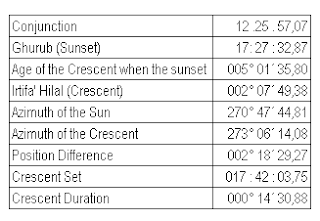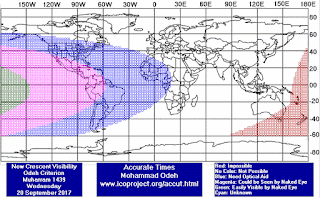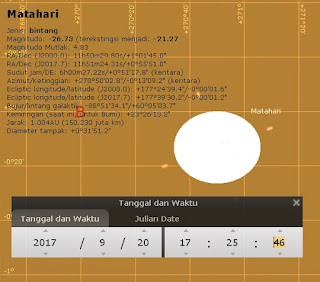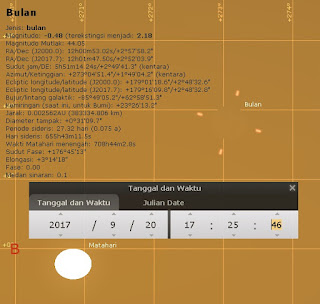
The year of 1438 H. will end. Soon, we will enter the new of hijriah year 1439 H. According to calculations in the book Ittifaq Dzatil Bain, conjunction of the end of the lunar month at the end of the year will occur on Wednesday, September 20, 2017, at noon at 12:25:57 UTC + 7.
We describe the calculation of 1 Muharram 1439 H using the book of Ittifaq Dzatil Bain, with Condrodipo as the point of observation:
The determination of the beginning of the month as well as the beginning of the year will be very interesting. why is that? because the height of crescent is low enough but slightly above the criteria of MABIMS. If calculated using the criteria M.Odeh crescent condition at Condrodipo on this month can not be seen (Not Possible).
We describe the calculation of 1 Muharram 1439 H using the book of Ittifaq Dzatil Bain, with Condrodipo as the point of observation:
 |
| Calculation of 1 Muharram at Condrodipo, Gresik |
 |
| Map of Crescent Visibility Source : Accurate Times |
Rukyatul hilal in condrodipo often results the appearance of a new moon. Though not a photographic image, but the result of the rukyatul hilal is still considered, and made as one of the basic determination of the beginning of the month in Indonesia.
Astronomers often mention that the moon with the criteria MABIMS very difficult to see, even impossible, but in reality the observers of rukyatul hilal not so. If the height of the hilal is above the criteria of MABIMS usually can be sure there is a report that Crescent is visible.
Further research is needed on this matter, which unites some opinions from various parties, astronomers, fiqh experts, and also the government.
1 muharram will occur on Thursday, 21 September 2017, it is based on MABIMS criteria, but for certainty we should follow the government's decision. Below! Simulation of rukyatul hilal 1 Muharram 1439 H in Condrodipo Gresik.
 |
| Simulation of Sunset at Condrodipo Source : Stellarium |
 |
Simulation of Rukyatul Hilal at Condrodipo
Source : Stellarium
|















